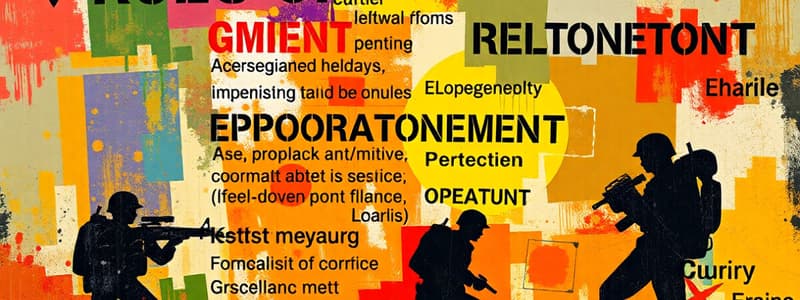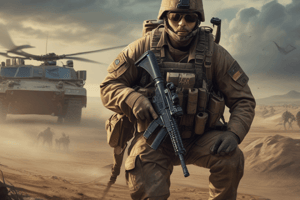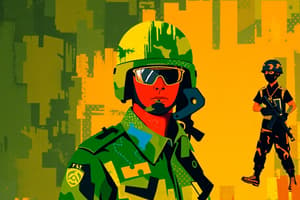Podcast
Questions and Answers
What occurs in a declared non-defended area?
What occurs in a declared non-defended area?
- Military equipment is allowed.
- Combat actions are permitted.
- No hostile actions are allowed. (correct)
- Only enemy forces may occupy.
Which of the following best describes a demilitarized zone?
Which of the following best describes a demilitarized zone?
- A zone allowed to have fixed military installations. (correct)
- A heavily fortified area with military presence.
- A location designated for military training activities.
- An area free of all combatants and military equipment. (correct)
Who is responsible for creating and managing the Rules of Engagement (ROE)?
Who is responsible for creating and managing the Rules of Engagement (ROE)?
- Local government officials.
- International peacekeeping organizations.
- Senior commanders with legal advisors. (correct)
- Military personnel without legal assistance.
What does the term 'war booty' refer to?
What does the term 'war booty' refer to?
What is prohibited in a demilitarized zone?
What is prohibited in a demilitarized zone?
Which of the following is classified as a non-combatant?
Which of the following is classified as a non-combatant?
What is the definition of medical personnel in a conflict setting?
What is the definition of medical personnel in a conflict setting?
Which of the following does not fall under the category of medical establishments?
Which of the following does not fall under the category of medical establishments?
What is meant by medical material?
What is meant by medical material?
Which statement best describes a merchant vessel?
Which statement best describes a merchant vessel?
Flashcards are hidden until you start studying
Study Notes
Non-Defended Areas and Localities
- Areas left open for enemy occupation without military action
- No hostile action is permitted within these areas
Demilitarized Zone
- All combatants, mobile weapons, and military equipment have been removed
- Hostile acts are prohibited
- Fixed military installations remain, but no further military activity should occur
Rules of Engagement (ROE)
- Directives outlining conditions for initiating or continuing combat
- Standing ROE apply generally, while specific ROE are for particular operations
War Booty
- Captured enemy military objects, excluding personnel identification cards, insignia, medical and religious items, and items needed to clothe, feed, and protect captured personnel
Medical Terminology
- Medical personnel do not include "ops medics" but may carry weapons for self-defense
- Medical establishments refer to hospitals and medical depots
- Medical transport includes transportation for search, rescue, and evacuation
- Medical Material is any equipment and resources used for medical care
Instrument Classification
- Categories for personnel, objects, and ships are defined based on permitted actions and restrictions.
Religious Personnel
- Personnel exclusively engaged in religious ministry may carry weapons for self-defense
Religious Objects
- All objects and articles of a religious nature are permitted
Prisoner of War (POW)
- POW status applies to lawful combatants and persons recognized in terms of relevant Geneva Conventions (H IV R, GII - GIII and GPI) who have fallen under the power of the opposing party.
- Combatants who surrender or fall to the enemy are entitled to POW status.
Warship
- A ship belonging to a state's armed forces that bears distinguishable marks of character and nationality, is commanded by an appropriately commissioned officer, and manned by crew under military discipline.
Prohibited
- Actions and weapon types completely forbidden under the Law of Armed Conflict (LOAC)
Restricted
- Combat actions and weapon types are restricted but may be utilized under specific conditions prescribed by LOAC
- Restricted actions and weapon types are limited by at least four fundamental LOAC principles
LOAC Concepts
Armed Forces
- All organized units and personnel under a command responsible for their behaviour
Auxiliary Vessel
- A vessel other than a warship, owned or controlled by a state's armed forces, used for non-commercial service
Combatants
- Recognizable members of armed forces, excluding medical and religious personnel
- To be considered a lawful combatant, a person must:
- Be under responsible command
- Wear a distinguishing sign
- Carry weapons openly
- Respect LOAC
Lawful Combatant
- Combatant engaging in hostile acts on behalf of a party to the conflict, authorized by a competent authority
Civilian "Combatants"
- Inhabitants of a non-occupied territory who, on the approach of an enemy, take up arms to resist the enemy in mass, in order to expel the enemy.
Combatants and Mercenaries in Armed Conflict
Combatants
- A person engaging in hostile acts during armed conflict on behalf of a party to the conflict
- Lawful combatants are directly authorized by a competent authority to engage in armed conflict
- Civilian combatants are inhabitants who spontaneously take up arms to resist the enemy
- They do not need to be organized or have a designated command
- They must bear arms openly and comply with the laws of armed conflict
- This resistance must occur suddenly, without time to organize into regular armed forces
Mercenaries
- Individuals who participate in armed conflicts mainly for financial reasons (monetary compensation)
- They are not considered lawful combatants and are considered criminals by international law
- The French Foreign Legion is an exception: members pledge allegiance to France and are commissioned in this way
- Captured mercenaries may be tried and punished according to the Geneva Conventions for acts related to directly participating in armed conflict, if those acts violate the conventions.
General Notes
- Compliance with the laws of armed conflict is emphasized.
- The document highlights the distinction between lawful combatants and mercenaries, noting different legal implications.
Studying That Suits You
Use AI to generate personalized quizzes and flashcards to suit your learning preferences.




